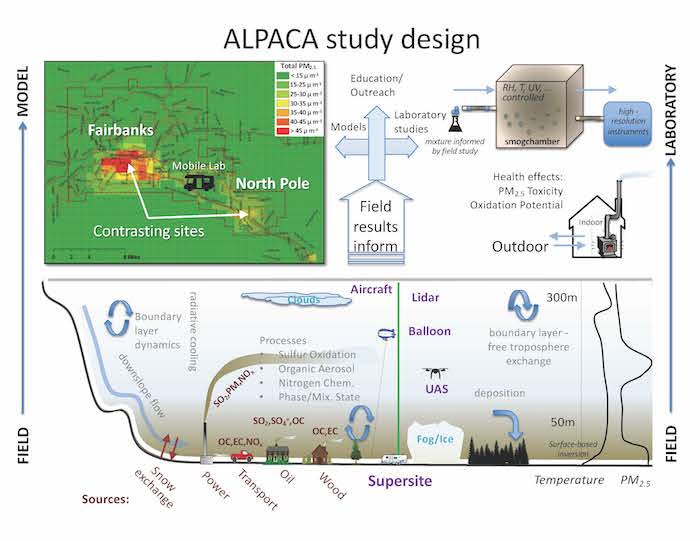By: William R. Simpson, Geophysical Institute and Department of Chemistry and Biochemistry, University of Alaska Fairbanks
The Alaskan Layered Pollution And Chemical Analysis (ALPACA) project seeks increased understanding of pollution processes relevant to Arctic conditions such as cold temperatures and low sunlight intensity. These wintertime Arctic conditions differ greatly from the more-studied pollution problems during summertime in the more populated mid-latitude regions. This project seeks to close knowledge gaps in understanding of atmospheric chemical mechanisms occurring under cold and dark conditions.
ALPACA project planning efforts have advanced during team meetings in the Arctic Community Meeting Rooms at the Fall 2017 and 2018 American Geophysical Union meetings and, with National Science Foundation funding, during a three-day workshop in Fairbanks, Alaska during May 2018. At this workshop, 44 scientists met to discuss the current state of the science regarding pollution under cold and dark conditions. The workshop arose from the International Global Atmospheric Chemistry (IGAC) Air Pollution in the Arctic: Climate, Environment, and Societies (PACES) activity, which aims to foster new collaborative research on Arctic air pollution at the international level. The outcome of this meeting was a whitepaper describing the findings of knowledge gaps and the design of an experiment to address these deficiencies. Members of the ALPACA research community are now seeking funding to carry out the ALPACA field study planned for January and February 2021. We welcome others to become involved in this project. Information on the project, workshop, and whitepaper can be found on the ALPACA website.

Pollution in Arctic cities and near industrial areas can be quite severe, with Fairbanks, Alaska being an extreme example that exceeds U.S. Environmental Protection Agency (EPA) fine particulate pollution standards for around a dozen days per winter. These small particles, having diameters less than 2.5 microns, are termed PM2.5 and are particularly unhealthy because they penetrate deep into the lungs where they deposit toxic compounds and irritate cells. PM2.5 is regulated by the EPA due to its correlation with adverse health effects. Fairbanks, like other Arctic cities, has strong pollution sources during wintertime when home heating, transportation, and energy production activities peak. These emissions are trapped near the ground by temperature inversions, leading to highly polluted air at ground level, where people breathe. The workshop found that many unknowns exist regarding this situation.
Specific areas needing better understanding regarding cold and dark pollution include the following topics. EPA observations show that Fairbanks PM2.5 pollution is dominated by organic compounds, which is quite different from lower-latitude cities like Salt Lake City, which is instead dominated by ammonium nitrate. These findings indicate that even during wintertime, sources and chemistry of Arctic pollution differ from lower latitude situations. These organic compounds largely come from wood smoke, but the contribution of oil and other fuels needs further study. Many of these organic compounds are semi-volatile, and are emitted as gases, but soon stick onto particles at colder temperatures, growing PM2.5 concentrations. Given the very cold conditions during Arctic wintertime, this process is relevant to both Fairbanks and the broader Arctic. A related question is what happens to PM-bound organic compounds when these particles infiltrate houses and are warmed? This question is relevant to resident's exposure because people spend much of their time indoors during the cold periods of wintertime. Sulfur is a common species in fuels (e.g. heating oil, coal), which, upon combustion, is mostly emitted as sulfur dioxide (SO2). A smaller fraction of fuel sulfur is emitted as sulfuric acid, which then sticks to and grows PM2.5 concentrations. However, we observe more particulate sulfate than EPA models predict, implicating atmospheric chemical reactions that oxidize SO2 to sulfate, or lack of understanding of emissions in this cold environment. In addition to emissions and chemistry, the structure of temperature inversions and cold pool meteorology that traps these pollutants needs study.
The ALPACA effort is growing and we welcome collaboration with others interested in these multi-disciplinary questions. Please feel free to contact Bill Simpson (wrsimpson [at] alaska.edu), the author of this article, or any member of the ALPACA team.
About the Author
 William (Bill) Simpson leads the Simpson Research Laboratory at the University of Alaska Fairbanks. The research group investigates Arctic radical chemistry through field measurements of trace gases and reactive radicals. The group works to understand the role of radical chemistry in determining the fate of pollutants in the Arctic, including organics and mercury, and how this fate may change in a rapidly changing Arctic. Bill's current interests are basic chemical processes in the Arctic, how they differ from lower-latitude atmospheric chemistry, and how they may change as the Arctic undergoes climate change.
William (Bill) Simpson leads the Simpson Research Laboratory at the University of Alaska Fairbanks. The research group investigates Arctic radical chemistry through field measurements of trace gases and reactive radicals. The group works to understand the role of radical chemistry in determining the fate of pollutants in the Arctic, including organics and mercury, and how this fate may change in a rapidly changing Arctic. Bill's current interests are basic chemical processes in the Arctic, how they differ from lower-latitude atmospheric chemistry, and how they may change as the Arctic undergoes climate change.
